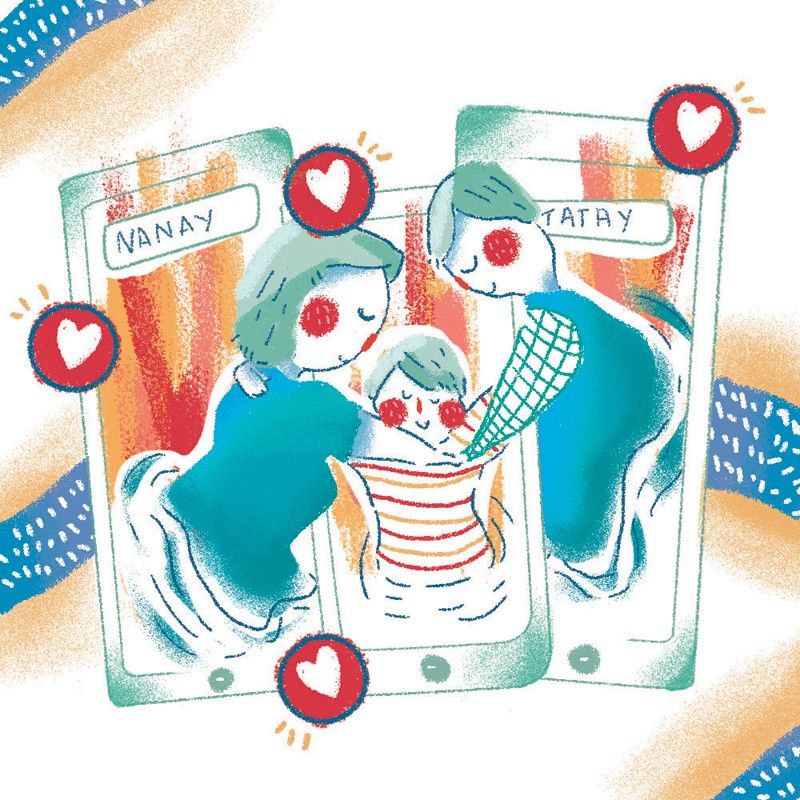Fragmented and Connected: Transnational Filipino family life in the digital age

MANILA, Philippines — The composition and dynamics of the Filipino family are at the forefront of rapid transformation over the past decades. Multiple changes in the household have been constantly shaped by the expansion of international businesses, increasing demands of overseas labor, as well as the advent of transport and communication technologies. For instance, in a report released by the Philippine Overseas Employment Administration (POEA), 2.5 million Filipino workers were deployed overseas in 2016. With the outward mobility of Filipinos from their household, a transnational family arrangement is birthed. Family members spread across continents use smartphones and social media platforms, as well as send remittances and care packages to maintain transnational linkages.
Historically, the massive deployment of Filipino workers to various continents across the world was considered a temporary stop-gap measure by the government to address poverty, underemployment and unemployment in the Philippines. It was during the 1970s when former President Ferdinand Marcos signed the Labor Code of 1974, formalizing the Philippine labor migration program. To date, the Philippines has become one of the major suppliers of femininized and skilled workers across the globe. Significantly, remittances sent by OFWs comprise 10 per cent of the Philippines’ GDP, keeping the economy afloat.
The transnational Filipino family is mobilized through mobile devices and networked communications platforms. This is not surprising given the widespread uptake and use of smartphones and social media platforms among Filipinos. According to the International Telecommunication Union (ITU), there were 115.824 million mobile-cellular subscriptions in the Philippines in 2017. Further, a recent report released by social management platform Hootsuite and We Are Social showed that Filipinos have been identified as the world’s heaviest Internet users, spending an average time of 10 hours and 2 minutes in using the Internet. Significantly, the integration of digital communication technologies into the everyday lives of a transnational Filipino household has paved the way for new practices and strategies to reclaim family life despite physical separation.
Mobile devices and online platforms play a crucial role in forging and sustaining long-distance familial relationships. For instance, overseas migrant parents utilize digital media platforms to perform parenting from afar. Left-behind children in the Philippines remain connected to their overseas parents. Even ageing left-behind parents back home have been given a chance to be parents again to their overseas-based adult children. In this vein, mobile technologies have facilitated the performance and enactment of familial roles, therefore maintaining a sense of doing family.
Mobile technology essentially brings diverse benefits to dispersed Filipino family members. Photos, texts, audio bites, and multimedia content are exchanged through messaging applications, therefore contributing to intimate interactions. The instantaneous sharing and tagging of photos on Facebook may let family members feel included in everyday or festive activities. Chatting while on the move through Skype can generate a sense of connectedness as well. Accessing news can be made through clicks and swipes on smartphone. Sending money and care packages has also become convenient. Ultimately, these diverse mobile practices demonstrate how the collapse of the ‘here’ and ‘there’ has enabled separated family members to remain virtually together.
Yet, the dependence on mobile technologies in sustaining long-distance relationships is not devoid of challenges and tensions. Based on my research that investigated how transnational Filipino family members in Australia used mobile devices to sustain ties, contradictory feelings often emerge in communication at a distance. For instance, the parameters of technology often stirred an intense longing for a loved one. A user could not hug or kiss a special someone through a smartphone. Feelings of sadness also arose during a time when one remained physically absent from taking care of a sick loved one, assisting a family member during an onset of typhoon, or celebrating a family milestone. Additionally, the uneven technological landscape between the host and home country also impacted transnational connections. Online interruptions caused by slow internet connectivity had to be dealt with patience. Transnational family members tended to suppress their feelings and opted to focus on securing a stable future.
A critical lens is needed to evaluate the proximity enabled by digital media use in a transnational household. By identifying the obstacles often constantly negotiated in sustaining family life from a distance, we consider digital media use as a site of struggle especially for those who have been forced to leave their left-behind loved ones. It is through this point that I encourage everyone to see beyond the potentials afforded by digital media channels in enabling transnational family life. There is a need to continuously call the attention of our government to provide jobs and social welfare services to Filipinos so that family separation can be curbed.
In a globalized era, the transnational Filipino household has become a powerful icon of Filipino domestic life. However, it also embodies the contradictory consequences of globalization. Virtual connectivity does not only provide the much-needed intimate connection needed in harnessing family life at a distance; it also becomes a source of tension and struggle, as a result of diverse social and technological factors. When technology fails, distance is deeply felt. In a networked era, smartphones, mobile social media and a wide range of personalized apps are key to enabling the formation of ties and relationships among separated family members. But we must not lose sight of the main causes of the fragmentation of the Filipino household. To approach the role of digital media in transnational family life is to always examine the contexts, social structures and political systems that have disrupted the physical togetherness of Filipino family members. - Earvin Charles Cabalquinto
* * *
Dr. Earvin Charles Cabalquinto is a lecturer in Communication in the School of Communication and Creative Arts at Deakin University. He is currently working on his manuscript about family life at a distance in the digital era.



















